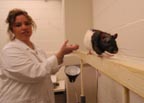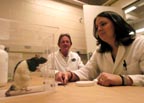March 29, 2006
Research may speed recovery from brain injuries
CARBONDALE, Ill. -- By stimulating one of the body's major nerves with small electrical pulses, researchers at Southern Illinois University Carbondale have helped head-injured rats quickly recover the physical and mental skills they had before their injuries.
"We have enhanced both the rate and the fundamental level of recovery to the point that they're performing as well as uninjured animals," said SIUC psychologist Douglas C. Smith, head of an interdisciplinary team of researchers that for more than 15 years has studied the effects of electrically stimulating the vagus nerve. Results of this most recent work appeared in the December 2005 issue of the Journal of Neurotrauma.
The vagus nerve runs from the brain through the torso.
"It controls all of your organs — your heart, your lungs, everything," Smith said.
"But that's only 20 percent of what it does. The other 80 percent of its function is taking information back to the brain. When we stimulate it, we're activating the brain."
In earlier studies reported in 1995 and 1998, the team showed that stimulating the vagus nerve enhanced memory and learning in rats. In the January 1999 issue of the journal Nature Neuroscience, team members reported that it did the same thing for humans with epilepsy.
From there, it was just a short step to look at what vagus nerve stimulation might do for those with the kind of brain injuries that result from a blow to the head. Some 1.4 million
Americans suffer such traumatic brain injuries each year, of which 80,000 to 90,000 survive with permanent disabilities, according to the Centers for Disease Control Web site.
"I know a doctor in Detroit who said he sees 20 such injuries each week from falls, motorcycle accidents and the like," Smith said.
The project began with graduate and undergraduate research assistants training rats to perform tasks that involved reaching, balance and learning. After the rats had learned these tasks, a graduate student anesthetized them and implanted electrodes on the vagus nerve in the necks of each, although only some of the rats would actually receive the stimulation.
"We wanted to avoid the possibility of bias when the measurements were taken," Smith said.
A week later, the student anesthetized the rats again. Some of them then received a measurable but moderate injury to the left side of the brain — similar to what might occur if a human head struck a windshield but didn't break it — sufficient to impair movement on the right side. The student then attached the electrodes' leads to small headpieces affixed to all of the rats' skulls.
Two hours after that, some of the injured rats began receiving a 30-second series of electrical impulses delivered to their headpieces every 30 minutes. Two days later, teams of graduate students started putting the rats through their paces, measuring their performance every other day for 14 days.
"By the end of the first week, we got a much more rapid recovery in the stimulated animals compared to injured animals that didn't get the stimulation," Smith said.
"By the 10th day, all the stimulated animals were no different from the sham-operated controls that had gone through the same surgical procedures but were not injured — they were performing just as well. And they were significantly better on all measures from the injured controls.
"We don't know if they were doing things exactly the same way they did them before the injury — that would take high-speed video analysis. But while we'd like to know the answer to that, right now it's not an important question. The important thing is these animals can function much better than the animals that were injured but not stimulated. They can manipulate objects. Regaining the use of a hand means a lot."
This current study showed what can be done with electrical stimulation delivered two hours after an injury, a timeline Smith acknowledges would prove dicey when it comes to human injuries, "though no one knows what two hours in a rat's life translates to in human terms," he pointed out.
A subsequent study, the report of which is now making its way through the journal review process, examined the results of such stimulation done 24 hours after the injury occurred.
"That's much more clinically relevant," Smith said.
"It's feasible to start stimulation the day after a head injury — and we found the same things regarding recovery. We replicated that it does work and it does enhance both recovery rate and final level of performance."
The team, which includes Smith, psychology colleagues Andrea Duke, Brittny L. Corrigan, Robert A. Jensen, Steven L. Neese, Rodney W. Roosevelt and Arlene A. Tan, as well as Ronald A. Browning from physiology and Richard W. Clough from anatomy, has received a one-year extension of the four-year, $1.14 million federal grant from the National Institute of Neurological Disorders and Stroke that sparked this project in 2002.
Smith also plans to work with researchers at the University of Miami medical school to see if electrical stimulation of the vagus nerve could prove effective in an experimental model that mimics stroke.
"When you have a stroke, the injury to the brain is much more focused than it is in a closed-head injury," Smith said.
"When you hit your head, you have injury at the site of the impact, but it also moves the entire brain. It jostles it, so you get much more widespread damage. But there's no reason to think that electrical stimulation wouldn't work on stroke."
A medical stimulation device developed by a Houston-based company called Cyberonics Inc. has already received Food and Drug Administration approval to treat epilepsy and depression. Resembling a cardiac pacemaker, the battery-operated implant can send electrical pulses directly to the vagus nerve. Though it has not been approved for treatment of brain injury, Smith said that at a recent meeting of the National Neurotrauma Society, he met a doctor who serves on the FDA advisory committee and was encouraged to think about beginning human clinical trials of the procedure now.
"We're quite excited about this — there's nothing like it (for the treatment of closed-head injuries)," Smith said.
"Vagus nerve stimulation also improves learning and memory, reduces seizures and is used for depression in humans. Some or all of these are known to occur following traumatic brain injury in humans. Thus, stimulation of the vagus nerve has the very exciting potential of dramatically improving the quality of life for people who experience closed head injury.
"To date, every treatment that's being tried involves drugs, but all drugs have side effects, and sometimes they can make people worse. The only side effects from vagus nerve stimulation are that people sometimes get hoarse or they get a sore throat."
Leading in research, scholarly and creative activities is among the goals of Southern at 150: Building Excellence Through Commitment, the blueprint the University is following as it approaches its 150th anniversary in 2019.

Rat race — Andrea Duke of
Carrier Mills, a doctoral
student in psychology at
Southern Illinois
University Carbondale,
works with a rat in a
vagus nerve stimulation
study on its balancing
skills. Download Photo
Here

Sweet! — As research team
leader Douglas C. Smith watches,
Brittny L. Corrigan of Hinckley,
a sophomore in zoology at Southern
Illinois University Carbondale,
teaches a rat in a vagus nerve
stimulation study to reach for
a sugar pellet. Download
Photo Here

Electrifying news — Southern
Illinois University Carbondale
researchers (from left)
Ronald A. Browning, Richard W.
Clough, Douglas C. Smith and
Robert A. Jensen have found
that electrically stimulating
the vagus nerves of head-injured
rats helps them recover quickly
and completely. Download Photo
Here
